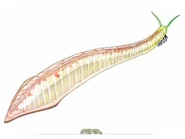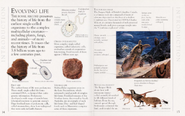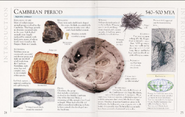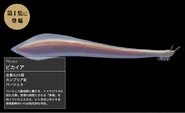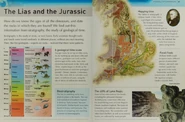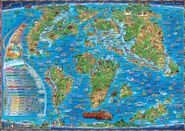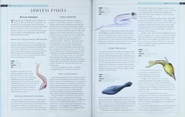| Pikaia | |
|---|---|
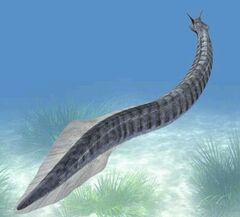
| |
| An artist's illustration of Pikaia gracilens | |
| Scientific classification | |
| Kingdom: | Animalia |
| Phylum: | Chordata |
| Family: | †Pikaiidae |
| Genus: | †Pikaia Walcott, 1911 |
| Species: | †P. gracilens |
| Binomial name | |
| †Pikaia gracilens Walcott, 1911 | |
Pikaia gracilens is an extinct animal known from the Middle Cambrian Burgess Shale of British Columbia that was the ancestor to all modern-day vertebrates. [1]
Description[]
Pikaia was a primitive chordate that lacked a well-defined head and averaged about 1+1⁄2 inches (38 mm) in length. Once thought to be closely related to the ancestor of all vertebrates, it has for that reason received particular attention among the multitude of animal fossils found in the famous Burgess Shale in the mountains of British Columbia, Canada. Pikaia had a pair of large, antenna-like tentacles on its head, and a series of short appendages, which may be linked to gill slits, on either side of its head. In these ways, it differs from the modern lancelet. The "tentacles" on its head may be comparable to those in the present-day hagfish, a jawless chordate.[3]
Although primitive, Pikaia shows the essential prerequisites for vertebrates. When alive, Pikaia was a compressed, leaf-shaped animal with an expanded tail fin; the flattened body is divided into pairs of segmented muscle blocks, seen as faint vertical lines. The muscles lie on either side of a flexible structure resembling a rod that runs from the tip of the head to the tip of the tail.[4] It likely swam by throwing its body into a series of S-shaped, zigzag curves, similar to the movement of eels; fish inherited the same swimming movement, but they generally have stiffer backbones. These adaptations may have allowed Pikaia to filter particles from the water as it swam along.[3] Pikaia was probably a slow swimmer, since it lacked the fast-twitch fibers that are associated with rapid swimming in modern chordates.[3]
Conway Morris and Caron (2012) published an exhaustive description based on all 114 of the known fossil specimens; they discovered new and unexpected characteristics[which?] that they recognized as primitive features of the first chordate animals. On the basis of these findings, they constructed a new scenario for chordate evolution.[5] Subsequently, Mallatt and Holland reconsidered Conway Morris and Caron's description, and concluded that many of the newly recognized characters are unique, already-divergent specializations that would not be helpful for establishing Pikaia as a basal chordate.[6]
Discovery[]
In 1911, Charles Walcott and colleagues were digging in the Burgess Shale deposit in British Columbia, when they came across the fossil of a previously unrecognized creature.

Pikaia Fossil
Walcott named it Pikaia gracilens, after the area "Pikaia's Peak" where the creature was discovered. At first, no one could tell exactly what genus it belonged in, but Walcott placed as a polychaete worm, since it greatly resembles a modern-day lancelet worm.
However, reexamination in 1979 by Simon Conway Norris made this creature more significant than previously thought. Norris discovered a very primitive, proto-notochord, which led him to believe Pikaia was in fact a chordate, and the earliest known ancestor to all vertebrates.thumb|250px|link=File:Pikaia.jpg This isn't universially accpeted, though, because its tentacles and cuticle aren't like anything found in modern vertebrates. The notochord is very intriguing, though, and whether or not Pikaia is a vertebrate ancestor or not is a very controversial debate in the paleontological field. About 114 specimens of this strange vertebrate have been found. The discovery of Pikaia also has lead to a controversy as to how diverse life was back in even the Pre-Cambrian period. [2]
Evolution[]
Much debate on whether Pikaia is a vertebrate ancestor, its worm-like appearance notwithstanding, exists in scientific circles. It looks like a worm that has been flattened sideways (lateral compression). The fossils compressed within the Burgess Shale show chordate features such as traces of an elongate notochord, dorsal nerve cord, and blocks of muscles (myotomes) down either side of the body – all critical features for the evolution of the vertebrates.
The notochord, a flexible rod-like structure that runs along the back of the animal, lengthens and stiffens the body so that it can be flexed from side to side by the muscle blocks for swimming. In the fish and all subsequent vertebrates, the notochord forms the backbone (or vertebral column). The backbone strengthens the body, supports strut-like limbs, and protects the vital dorsal nerve cord, while at the same time allowing the body to bend.
A Pikaia lookalike, the lancelet Branchiostoma, still exists today. With a notochord and paired muscle blocks, the lancelet and Pikaia belong to the chordate group of animals from which the vertebrates descended. Molecular studies have refuted earlier hypotheses that lancelets might be the closest living relative to the vertebrates, instead favoring tunicates in this position; other extant and fossil groups, such as acorn worms and graptolites, are more primitive.
The presence of a creature as complex as Pikaia some 530 million years ago reinforces the controversial view that the diversification of life must have extended back well before Cambrian times – perhaps deep into the Precambrian. The discovery of Metaspriggina, a primitive fish of similar age which seems to have already started to develop a jaw and the presence of conodonts, the teeth of an extinct type of fish belonging to the Agnatha some 20 MA before Pikaia, does provide support for that view.
Paleobiology[]
Pikaia is a very peculiar-looking creature. At first glance, it'd appear to resemble a lancelet worm, but closer examination revealed that in fact had a notochord, which is a dorsal nerve chord that goes all the way down its back.
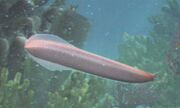
This has lead many scientists to believe that this is the blue-print for a backbone, and this would make Pikaia the earliest known ancestor of all modern vertebrates, from fish to mammals, birds, reptiles, and amphibians.

It had a flat body, making it look almost like a species of flatworm. Its tail ended in an almost fin-like structure, and probably allowed it to swim much like an eel. [3] Pikaia also had strange, tentacle-like appendages on its "head", and most scientists believe that this eventually lead to gills and fins in fish. Its body also has faint rows of segmented muscle blocks that go all the way down its body. It likely lived in the deep oceans during the Cambrian period and was constantly on the look-out for predators such as Anomalocaris. [4][5]
In popular culture[]
- It makes an appearance in the first episode of Leaps in Evolution.
- Its name is somewhat used in an anime with the same name.
Gallery[]
References[]
- ↑ https://www.nature.com/articles/nature16992
- ↑ http://bioteaching.wordpress.com/2012/10/16/pikaia-one-of-the-earliest-chordates/
- ↑ http://paleobiology.si.edu/burgess/pikaia.html
- ↑ http://dinosaurs.about.com/od/tetrapodsandamphibians/p/pikaia.htm
- ↑ http://burgess-shale.rom.on.ca/en/fossil-gallery/view-species.php?id=101&ref=i&
